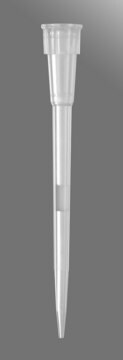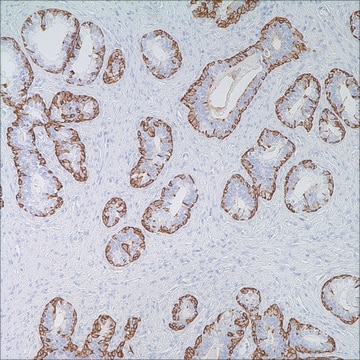460R-1
Heat Shock Protein 70 (EP377) Rabbit Monoclonal Primary Antibody
About This Item
Prodotti consigliati
Origine biologica
rabbit
Livello qualitativo
100
500
Coniugato
unconjugated
Forma dell’anticorpo
culture supernatant
Tipo di anticorpo
primary antibodies
Clone
EP377, monoclonal
Descrizione
For In Vitro Diagnostic Use in Select Regions
Stato
buffered aqueous solution
Reattività contro le specie
human
Confezionamento
vial of 0.1 mL concentrate (460R-14)
vial of 0.1 mL concentrate Research Use Only (460R-14-RUO)
vial of 0.5 mL concentrate (460R-15)
vial of 1.0 mL concentrate (460R-16)
vial of 1.0 mL concentrate Research Use Only (460R-16-RUO)
vial of 1.0 mL pre-dilute Research Use Only (460R-17-RUO)
vial of 1.0 mL pre-dilute ready-to-use (460R-17)
vial of 7.0 mL pre-dilute ready-to-use (460R-18)
vial of 7.0 mL pre-dilute ready-to-use Research Use Only (460R-18-RUO)
Produttore/marchio commerciale
Cell Marque®
tecniche
immunohistochemistry (formalin-fixed, paraffin-embedded sections): 1:25-1:100 (concentrated)
Isotipo
IgG
Controllo
hepatocellular carcinoma
Condizioni di spedizione
wet ice
Temperatura di conservazione
2-8°C
Visualizzazione
cytoplasmic, nuclear
Informazioni sul gene
human ... HSPA1A(3303)
Categorie correlate
Descrizione generale
Qualità
European Union - IVD
Japan - RUO
Stato fisico
Nota sulla preparazione
Note: This requires a keycode which can be found on your packaging or product label.
Download the latest released IFU
Note: This IFU may not apply to your specific product lot.
Altre note
Note legali
Non trovi il prodotto giusto?
Prova il nostro Motore di ricerca dei prodotti.
Codice della classe di stoccaggio
12 - Non Combustible Liquids
Classe di pericolosità dell'acqua (WGK)
WGK 2
Scegli una delle versioni più recenti:
Certificati d'analisi (COA)
Non trovi la versione di tuo interesse?
Se hai bisogno di una versione specifica, puoi cercare il certificato tramite il numero di lotto.
Possiedi già questo prodotto?
I documenti relativi ai prodotti acquistati recentemente sono disponibili nell’Archivio dei documenti.
Filtri attivi
Il team dei nostri ricercatori vanta grande esperienza in tutte le aree della ricerca quali Life Science, scienza dei materiali, sintesi chimica, cromatografia, discipline analitiche, ecc..
Contatta l'Assistenza Tecnica.








